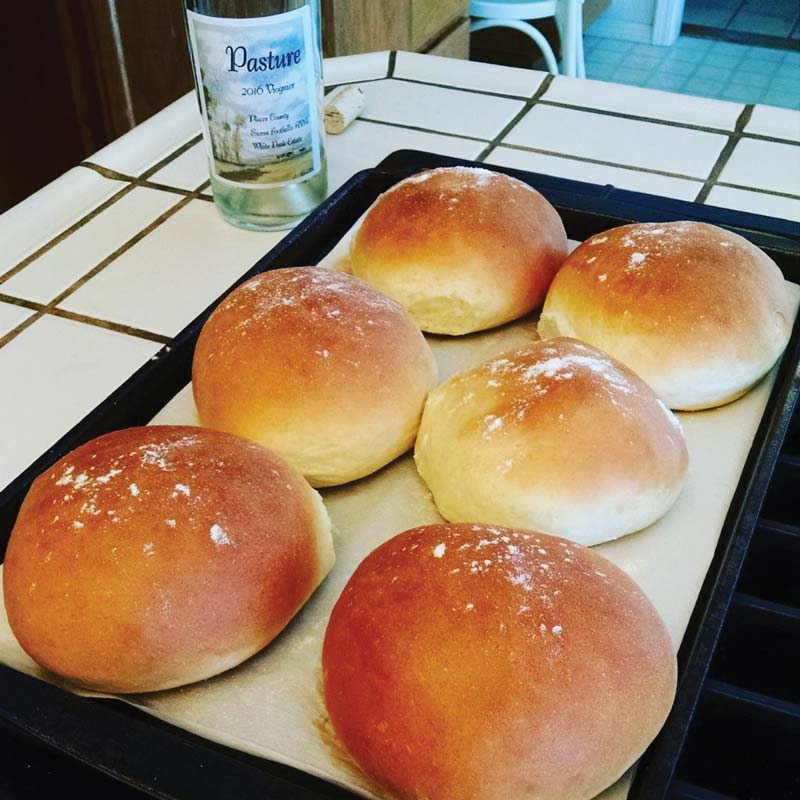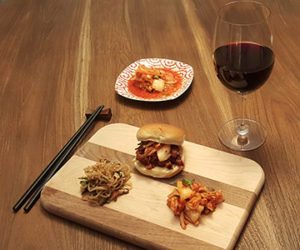Fermenting foods to pair with your wine
After I started making wine and beer many years ago, I became intrigued with all the other good things that beneficial microorganisms do for us. While I was part owner of a homebrew and home winemaking store, we hired associates who had done some kind of fermentation before they applied with us. As a result, we met highly skilled people who had made not just adult beverages but also sourdough bread, cheese, pickles, sauerkraut, hot sauce, and charcuterie.
By now, I have turned my hand to a number of these as well. I have not found much in the way of pairings with my wine for pickles, sauerkraut, or hot sauce, but some of the other categories have turned out quite well. This column will point you in some directions where you may find new enjoyment putting microbes to work. Three categories that offer almost certain success with wine pairing are breads, dairy products, and meats.
Breads
When considering fermentation of bread, sourdough immediately comes to mind. Since I live in Sonoma County — not far north of San Francisco — local sourdough is everywhere and bakers take great pride in their products. The distinguishing characteristic of sourdough bread compared with regular bread is the combination of organisms. Various strains of Lactobacillus bacteria, combined with wild or feral yeast, produce lactic acid sour flavor and carbon dioxide leavening. Home sourdough bread bakers often maintain a mixed culture or starter by periodically “feeding” it with flour and water. If you know someone who maintains a starter, they will probably share some with you, since the feeding inevitably also grows more starter.
It is possible for you to begin your own starter as well, reflecting the unique environment and terroir of your location. Our own Wine Wizard, Alison Crowe, posted the beginning of a new starter on social media during the 2022 harvest season. She used Chardonnay grapes from her Carneros Diamond Ranch vineyard for local microbiota. (She has also detailed her process in the August-September 2020 issue of WineMaker, also found at https://winemakermag.com/wine-wizard/wine-yeast-to-make-bread.) After beginning her indigenous ferment in September, she posted a picture of a beautiful sourdough loaf in early October.
Mary Karlin, in her book Mastering Fermentation, provides a detailed step-by-step method using organic raisins as a source for the wild microbes. Once you have your sourdough starter, you can make the full range of baked goods that ordinarily use conventional yeast — pizza, pancakes, rolls, and bread are all within your reach. For wine pairing, make a sourdough baguette or the similar Mexican roll from Guadalajara called birote salado. Sliced and arranged on a board with cheeses and cured meats, you will have a perfect match for any bold-flavored wine, red or white.

While sourdough may come to mind first, conventional yeast-leavened bread is also a fermented food. The Fleischmann’s yeast packets that my wife, Marty White, uses for her bread baking look a lot like the Red Star and Lalvin packages that we use in winemaking. For wine pairing, my new favorite yeast-baked bread treat is garlic knots, like you might get at a pizzeria. During the 2022 holiday season, Marty was making hamburger buns and some mini loaves with her favorite white bread yeast dough recipe. She gave me a little chunk of the dough and I made garlic knots to accompany a homemade pizza dinner. The pairing was outstanding with a local Sangiovese. Garlic knots are traditionally made from pizza crust dough, and this is the link I followed in adapting them to a traditional white bread recipe: https://www.simplyrecipes.com/recipes/garlic_knots/
Dairy Products
Cheese is the first food I want to mention here. While direct-acid-addition cheeses like ricotta and mozzarella also pair nicely with wine, today we are addressing microbes. One of the simplest of the cultured cheeses is chèvre, made from goat’s milk. Fromage blanc can be made from cow’s milk with the same supplies, culture, and equipment. Broadly, cheese cultures are various groups of bacteria classified as mesophilic, growing effectively at moderate temperatures, and thermophilic, thriving at slightly higher temperatures.
Making Chèvre
The culture I always use for chèvre is freeze-dried Danisco MA 4001 or the interchangeable variant MA 4002. This mixed culture contains three mesophilic Lactococcus cultures and one thermophilic Streptococcus culture. For these cheeses, milk is gently warmed to 86 °F (30 °C) and a small amount of the culture is stirred in. Many recipes also recommend adding calcium chloride to help ensure that sufficient calcium is available for good curd formation. Rennet, the coagulating agent, is then stirred in. I like to use Marzyme vegetarian rennet, but animal-derived rennet works equally well.
The fermenting milk then rests overnight at a temperature above 72 °F (22 °C) and curds form. In the morning, you gently ladle the curds into perforated cheese molds and allow whey to drain out until the following morning. This time, you salt the cake of cheese that now occupies the bottom quarter or third of your mold, gently turn it out, and salt it again. Allow to ripen overnight one more time and you have a delightful spreadable cheese. For goat cheese pairing, I especially like aromatic white wines like Gewürztraminer, Viognier, or Torrontés. Not quite as aromatic, I have offered my home-grown Chardonnay to cheesemaking class students with fresh chèvre on several occasions and received no complaints!
If you think you would like to try cheesemaking, it is easiest to buy a chèvre making kit from a supplier like New England Cheesemaking Supply, The Beverage People (the store I am now retired from), or one of the many wine supply shops that also offer such kits, or search for a kit online. You will get culture, rennet, and molds in most kits, other supplies may vary.
Making Crème Fraîche
Crème fraîche is another cultured dairy product that is even easier than chèvre and has a historical and delightful wine pairing. For the culture, I have used the same MA 4001 mentioned earlier with very good results. For a little more buttery aroma, you can instead try Abiasa Aroma B. It is also a mesophilic blend but includes a couple of bacteria strains that produce more aromatic fermentation compounds.
For the crème, start with a pint (473 mL) of the best local heavy whipping cream you can find (not ultra-pasteurized). I like to make my crème fraîche directly in a pint-size mason jar to reduce cleanup and have a storage container all at once. If you want to do the same, pour off a couple of ounces (~60 mL) of the cream for another purpose before pouring the rest into the jar so you have a little headspace. Now put the jar of cream in a two-quart (2-L) saucepan and add warm water to the pot to cover about ¾ the height of the jar. Use a stainless steel iced-tea spoon to stir the cream, adding ¼ tsp. (1 mL) of cheese culture that you have dissolved in two ounces (60 mL) of chlorine-free water. Turn the heat on and gently raise the temperature of the cream to 86 °F (30 °C). Check the temperature of the water and adjust to 86–88 °F (30–31 °C) by adding hot water or an ice cube to the water bath as needed.
Loosely put the lid on the jar and put it all — pot, water bath, and jar of cream — someplace where it can stay warm. I like to use a polystyrene foam shipping box that neatly fits the pot and jar that I use. Let the cream culture sit overnight, then stir it up the next day. It will be thick, kind of like creamy yogurt, but it is not really done yet. Chill for a few hours and it will get to a stiffer, spreadable consistency and develop a tangier flavor.
It is delicious as-is to spread on a bagel or dolloped on fresh strawberries. It is also great for cooking — it blends very well and a half cup stirred into marinara sauce will give you a great tomato cream sauce instantly. Then there is the classic pairing: With caviar and Champagne (or homemade sparkling wine). Using toasted slices of that sourdough baguette or birote that you made at the start of this column, or using small sourdough buckwheat pancakes, spread with your crème fraîche. Top each one with a small scoop of sustainably raised caviar (like Tsar Nicoulai brand, farmed in California). Now pair with your crisp, refreshing, homemade sparkling wine and prepare to be delighted.
Meats
Perhaps the most unusual of my various fermentations is meat. To make a tangy, well-stabilized salami, bacteria cultures are used to rapidly produce lactic acid and lower the pH to below 5.0 in four days or less, helping to protect against spoilage during the remainder of the month or so that it takes to dry salami. The salami I have enjoyed making in this manner is Calabrese salami, flavored with dried chili pepper flakes.
Making Calabrese Salami
For guidance to this category of cured meats I recommend The Art of Making Fermented Sausages by Marianski and Marianski. For this salami, I start with boneless pork shoulder and add some beef chuck and some pork back fat. In addition to chili flakes, flavorings include salt, garlic, fennel seed, black pepper, and red wine (homemade, of course). The culture is Bactoferm F-RM-52 made by Chr. Hansen, a producer of several winemaking cultures as well. This blend consists of Lactobacillus sakei and Staphylococcus carnosus. The bacteria grow primarily on dextrose or fructose, so my recipe includes 30 g of dextrose (corn sugar) in a five-pound (2.3-kg) batch of sausage. For further protection against spoilage, I add 6 g of Instacure #2 that contains salt, sodium nitrite, and sodium nitrate. After grinding the meat, mixing in the other ingredients, and finally stirring in the culture (dissolved in water), the sausage is stuffed into natural hog casings and tied into links.
The next step is where things get a bit odd. Since both bacteria strains grow most vigorously at 86 °F (30 °C), you cover the coils of sausage with clean towels and hold the meat at that temperature for 12 hours. To do that, I make a small curing space within my winemaking barn by hanging Mylar thermal blankets from the ceiling and placing a small space heater inside. If you try this, set it up a few days ahead so you can get the thermostat dialed in at 86 °F (30 °C). After that incubation period, the salamis hang at 60 °F (15.5 °C) and 60 to 70% humidity until they lose 30% of their original weight.
Although possibly shelf stable at that point, I keep mine in a zipper bag in the freezer, thawing one whenever I want it. As you might expect from this chili and red wine Italian-style salami, red wines pair especially well. I have found Sangiovese and Primitivo to be good choices, but any dry red with good acidity should pair well, too.
Now that you have tried fermenting all these foods, here is a suggestion for a grand finale (which I have not actually done). Make yourself a sourdough pizza crust, top it with your tomato cream sauce, add sliced Calabrese salami, finish with dollops of chèvre or fromage blanc, and pop it in the oven. Wood-fired, of course.





